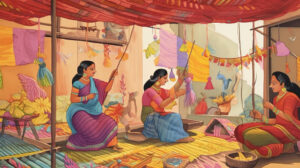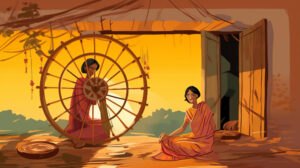Understanding Kala Proponents As Artisans And Their Skill As Artisanal
The ancient educational system of India was flexible, in that it was not just confined to the 14 vidyas. The 64 kalas, called the “Chausat kalas” were covered in the traditional education, as well. Acquiring the knowledge of the 14 vidyas required the students to possess a minimum level of scholastic abilities. And, not every child had that.
 For students not having that aptitude and capabilities, the choice of getting educated in any of the kalas was there. No child was deprived of the right to education; such was the uniqueness of the Bharateeya sanatana dharma.
For students not having that aptitude and capabilities, the choice of getting educated in any of the kalas was there. No child was deprived of the right to education; such was the uniqueness of the Bharateeya sanatana dharma.
The Chausat Kalas as professions
In that ancient system, individuals receiving education in any of the kalas had an option. That is, with regard to making a profession out of the knowledge and skills acquired.
 These people were expected to have “service” as the primary objective, and not get carried away purely by commercial motives. They were expected to strike a balance between “livelihood” and “service to people.” In fact, while undergoing education in the Kalas, teachers used to impart knowledge about how to arrive at that balance.
These people were expected to have “service” as the primary objective, and not get carried away purely by commercial motives. They were expected to strike a balance between “livelihood” and “service to people.” In fact, while undergoing education in the Kalas, teachers used to impart knowledge about how to arrive at that balance.
Proponents of kalas as artisans
Quite a number of the 64 kalas also included crafts where the practitioners had to make use of their hands to make functional and innovative items. Here, practitioners relied on several techniques that they learned in their schools. Owing to this very aspect, proponents of the kalas can be termed as artisans, too.
 For, an “artisan” refers to a person who uses their hands to execute work that involves the presence of specialized skills. And, the logical reference then would be: The competencies of the kala proponents can undoubtedly be categorized as “artisanal.”
For, an “artisan” refers to a person who uses their hands to execute work that involves the presence of specialized skills. And, the logical reference then would be: The competencies of the kala proponents can undoubtedly be categorized as “artisanal.”
The artisanal angle of Chausat Kalas – more details
Many kalas involve skillfully using the hands, to make various products and items. In this context, a point of utmost importance necessitates special mention. It needs to be understood that before the world witnessed the Industrial Revolution, the major chunk of manufacturing activity was attributable to the efforts of artisans. Thus, it can be said that the economic structure of society was heavily dependent on artisanal abilities, in those days.
 We have to note that beverages, food products, decorative pieces, etc., now being manufactured in factories were effortlessly made by artisans in ancient India. This once again emphasizes the glory of ancient Indian education. Students were transformed into skilled craftsmen who could create beautiful products just by depending on their hands. In this connection, the terms “artisan” and “craftsman” can be used synonymously.
We have to note that beverages, food products, decorative pieces, etc., now being manufactured in factories were effortlessly made by artisans in ancient India. This once again emphasizes the glory of ancient Indian education. Students were transformed into skilled craftsmen who could create beautiful products just by depending on their hands. In this connection, the terms “artisan” and “craftsman” can be used synonymously.
Respect for craftsmen in Bharatiya and Eastern cultures
In the Colonial re-education and cultural changes, many good things about Bharatiya and other Eastern Cultures were damaged or destroyed. Even in Japanese culture, a lot of respect is given to craftsmen who create works of art and utility items with just their hands. “Shokunin” is the Japanese term that refers to artisans who use their skills with a sense of social responsibility. Social welfare is the topmost priority of these artisans.
In this regard, it has to be stated that these are the precise values that were provided to pupils learning the kalas, in ancient Bharat. It is interesting to know that on every New Year’s Day in Japan, all the tools related to professional activity are honored in their traditional way. This is comparable to the “Ayudha pooja” in India, during the Dussehra festival. To have a day set aside to remember, respect, and celebrate the tools shows the amount of respect that Bharatiya civilization had for arts, artisans, and artisanal items.
Suggested Reading:
Understanding Sanathana Dharma
Why Is Aatmikta Called Direct Route To Happiness?
Demerits Of Macaulay Education System
How Hindu Dharmik System Helps Develop Good Character In Children And Youth?
